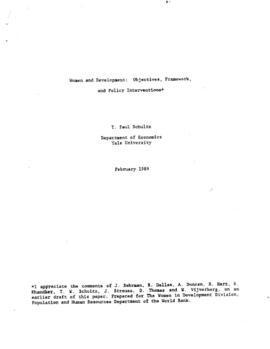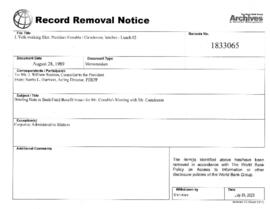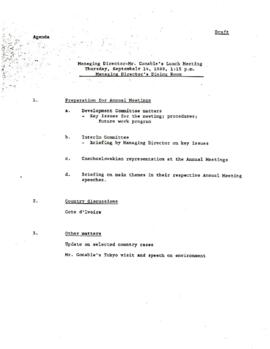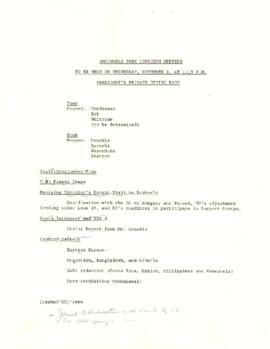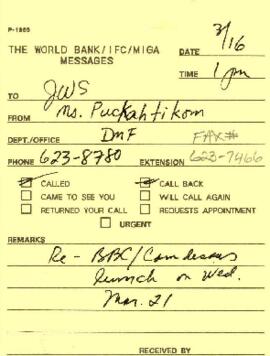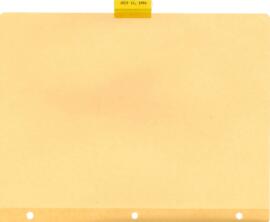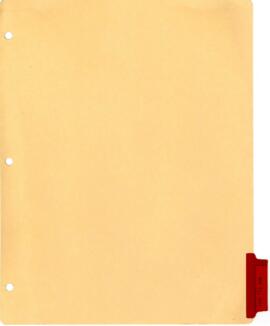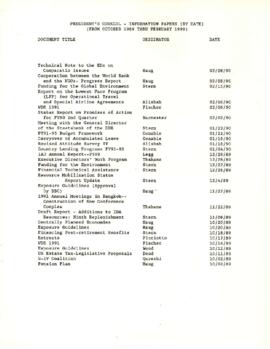Identity area
Reference code
Title
Date(s)
- 1986 - 1991 (predominant) (Creation)
Level of description
Subfonds
Extent and medium
62.80 linear feet of textual records; 893 photographs; 1 video tape
Context area
Name of creator
Biographical history
Barber Benjamin Conable (1922-2003), the World Bank Group's seventh President, was a career politician and had no substantial Wall Street experience. Conable had a background in law, graduating at Cornell University Law School in 1948. After serving in both World War II and Korea, he established a practice in New York. He later opted for a political career, first becoming a Republican member of the New York state senate, and then, in 1964, a member of the US Congress, where he served ten consecutive two-year terms.
Conable's first order of business upon becoming President in 1986 was to identify ways to trim the Bank's budget. It was decided that a major reorganization of the Bank would be the most effective way to create significant savings. An external consulting firm was hired to analyze the Bank's operations and an internal committee was appointed to implement the changes. The most significant result of the 1987 reorganization was the Country Department, rather than the Regional Vice Presidencies, became the basic program and budget unit. Two new Senior Vice Presidents for Policy, Planning and Research (PPRSV) and Administration (SVPAD), were also created. The latter became the Senior Vice President, External Affairs and Administration (EAASV) in 1988.
The ongoing debt crisis was another issue that Conable faced upon his arrival at the Bank. Initiatives such as the U.S.-sponsored Baker Plan attempted to alleviate debt in developing countries by urging financial institutions and commercial lenders to lend new monies to countries engaged in acceptable structural reforms. However, these initiatives found limited success. Initially, Conable and the Bank rejected calls for debt relief, but by 1987 a new debt-restructuring package to reduce existing debt and supplement new lending was announced by the Bank. The debt crisis contributed to increased cooperation between the Bank and the International Monetary Fund (IMF), resulting in jointly authored policy framework papers and, in 1989, a Concordat that allocated primary responsibilities between the two institutions.
Conable attempted to address criticism of the Bank's impact on the environment by strengthening environmental safeguards. An Environment Department was created in the 1987 reorganization. Its responsibilities were to review and direct research and policy on the environment and to conduct regular discussion with borrowers on the environmental implications of proposed projects. In addition, technical departments located in each regional vice presidencybegan reviewing projects for environmental soundness and were responsible for assisting in the implementation of specific environmental measures. The Bank also became involved in a number of highly visible international environmental efforts, including, alongside the United Nations, the creation of the Global Environment Facility (GEF) in 1990. Another result of this increased focus on the environment was a more open and collaborative relationship between the Bank and nongovernmental organizations (NGOs).
Conable also played a role in enlarging the role of other sectors focused on the social dimensions of development. He appointed a task force of senior staff to review the Bank's poverty programs and emphasized the connection between women and development by increasing the responsibility of the nascent Women in Development sector.
International Finance Corporation (IFC) operations continued to increase under Conable. It continued expansion into Africa and South Asia and into new areas of activity, such ascapital market development, corporate restructuring, and assistance to small and medium enterprises. Notably, the Multilateral Investment Guarantee Agency (MIGA), which was conceived during A. W. Clausen's term as World Bank Group President, was launched in 1988. Its purpose was to insure private investors against political risks and thereby promote private investments in developing countries.
The Conable tenure at the Bank witnessed the breakdown of the Soviet bloc and the transformation of Eastern European economies. The World Bank along with the IMF played a central role in the economic transition. The Bank participated in a comprehensive needs assessment of the Soviet economy. A World Bank office was opened in Moscow in 1991 and Conable traveled to Eastern Europe to offer advice and assistance, signing the first loan agreement with Poland in 1990.
Conable instituted a change to the senior management structure in 1987, replacing the former Managing Committee with the new Policy Committee. The new Committee, which served as the principle advisory body to the President, was comprised of: the President; Chairman; Senior Vice President, Operations; Senior Vice President, Finance; Senior Vice President, Policy, Planning and Research; Senior Vice President, Administration (later the Senior Vice President, External Affairs and Administration); the Executive Vice President of the IFC; and the Bank's General Counsel.
Conable served a single term as President, leaving the Bank in August 1991.
Repository
Archival history
Immediate source of acquisition or transfer
Content and structure area
Scope and content
Barber B. Conable's term as President was noted for the major reorganization of the Bank he directed in 1987 and the emphasis on poverty reduction as a central mission of the Bank. He identified environmental protection as an important goal, culminating in the Bank joining with the UN Development Program and the UN Environment Program to establish the Global Environment Facility in 1991. Conable supported an increased role for women in development and he appointed a woman, Marianne Haug, to his senior staff. Broad political changes occurred in Eastern Europe during his tenure, and he maintained extensive liaisons with international organizations including the increasingly influential NGO community. Conable also authorized the project to write a history of the Bank; Brookings Institution was given the contract for the study which resulted in the two volume The World Bank: Its First Half Century. Conable gave the authors access to his Presidential files, and the use of some of the files by the Brookings team is noted in the series descriptions.
The records of President and his staff are extensive. The minutes of his President's Council reveal the mechanisms of Bank management. The usual Annual Meeting files are supplemented by his country files and the records of his travels around the globe. The two series of liaison files show his political skills with varied constituencies.
The records of the Office of the President also include separate series of records of the Executive Counselor to the President, J. William Stanton; the Executive Assistant, Marianne Haug; and the Special Assistant, Anapum Khanna. The file of Conable's Executive Assistant, Jennifer A. Volk, on the lunches between Conable and Michel Camdessus, the Managing Director of the International Monetary Fund, is a separate series, while within the President's files on travel and Annual Meetings are other files that Volk maintained.
Appraisal, destruction and scheduling
Accruals
Accruals are not expected.
System of arrangement
Conditions of access and use area
Conditions governing access
Records are subject to the World Bank Policy on Access to Information.
Conditions governing reproduction
Records are subject to the Copyright Policy of the World Bank Group.
Language of material
- English
Script of material
Language and script notes
Physical characteristics and technical requirements
Finding aids
Allied materials area
Existence and location of originals
Existence and location of copies
Related units of description
Notes area
Alternative identifier(s)
Access points
Subject access points
Place access points
Name access points
Genre access points
Description control area
Description identifier
Institution identifier
Rules and/or conventions used
Internal World Bank Group Archives rules based on ISAD(G).
Disclosure status
Level of detail
Dates of creation revision deletion
16 August 2006



